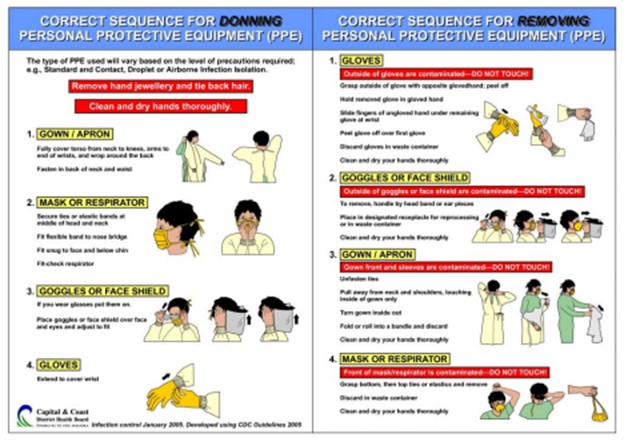A nurse is caring for a client who is in contact isolation. When exiting the client's room, in what order should the nurse take the following steps when removing her personal protective equipment? (Move the nursing actions into the box on the right, placing them in the selected order of performance. All steps must be used.)
Remove gloves.
Remove protective eyewear.
Remove gown.
Remove mask
Perform hand hygiene.
The Correct Answer is A,B,C,D,E
When removing personal protective equipment (PPE) after caring for a client in contact isolation, the nurse should follow the steps in the following order:
1. Remove gloves.
2. Remove protective eyewear.
3. Remove gown.
4. Remove mask.
5. Perform hand hygiene.
By following this sequence, the nurse ensures that the removal of PPE is done in a way that minimizes the risk of contamination. Removing gloves first helps prevent the spread of potential contaminants on the hands. Removing protective eyewear next avoids any potential contact with the face or eyes during the removal process. Removing the gown comes next, followed by the mask. Lastly, performing hand hygiene after removing all PPE helps ensure the hands are thoroughly cleaned.

Nursing Test Bank
Naxlex Comprehensive Predictor Exams
Related Questions
Correct Answer is ["B","D"]
Explanation
When reinforcing teaching with a client who has a duodenal ulcer and a new prescription for cimetidine, the nurse should include the following instructions:
"Avoid taking the medication at bedtime.": Cimetidine is most effective when taken during waking hours to help control gastric acid secretion. Taking it at bedtime may not provide optimal therapeutic benefits.
"You will need to continue taking this medication for up to 6 weeks.": Cimetidine is often prescribed for the treatment of duodenal ulcers and may require several weeks of continuous use to promote healing. It is important for the client to understand the duration of treatment and the need for adherence to the prescribed regimen.
The following statements are incorrect or not applicable:
"Drinking grapefruit juice while taking cimetidine can lead to toxicity.": Cimetidine does not have a known interaction with grapefruit juice. However, it is always important to consult the healthcare provider or pharmacist about potential drug interactions, including those related to specific foods or beverages.
"Take an antacid 30 minutes prior to taking cimetidine to minimize stomach upset.": Cimetidine is an H2 receptor antagonist that works by reducing stomach acid production. It is not necessary to take an antacid prior to taking cimetidine to minimize stomach upset. However, if the client experiences stomach upset or discomfort, they should consult their healthcare provider for further guidance on managing these symptoms.
Correct Answer is A
Explanation
The purpose of the stool guaiac test, also known as the fecal occult blood test (FOBT), is to identify the presence of hidden or occult blood in the stool. This test is commonly performed to screen for gastrointestinal bleeding, which can indicate various conditions such as colorectal cancer, ulcers, polyps, or other sources of bleeding in the digestive tract.
The other options mentioned are not specifically detected by the stool guaiac test:
Parasites: The stool guaiac test does not directly detect parasites in the feces. Parasite testing requires a different type of analysis, such as microscopic examination or specialized laboratory tests.
Bacteria: The stool guaiac test does not specifically detect bacteria in the feces. If a bacterial infection is suspected, other diagnostic tests such as stool culture or polymerase chain reaction (PCR) may be ordered.
Fat: The stool guaiac test is not designed to detect fat in the feces. If there is a concern about fat malabsorption, other tests such as fecal fat analysis or Sudan stain may be used.
Whether you are a student looking to ace your exams or a practicing nurse seeking to enhance your expertise , our nursing education contents will empower you with the confidence and competence to make a difference in the lives of patients and become a respected leader in the healthcare field.
Visit Naxlex, invest in your future and unlock endless possibilities with our unparalleled nursing education contents today
Report Wrong Answer on the Current Question
Do you disagree with the answer? If yes, what is your expected answer? Explain.
Kindly be descriptive with the issue you are facing.
